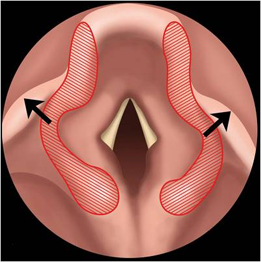Laryngomalacia
Laryngomalacia meaning soft larynx is the most common congenital cause of noisy breathing, or stridor associated with feeding difficulties, in the newborn.
It is a condition in which the supraglottic tissues situated above the vocal cords, are soft and floppy. The epiglottis is curled up (tube or omega shape) and is a typical feature of this condition. In severe cases, the epiglottis can be retroflexed, touches the pharynx and completely occludes the airway. Everytime the baby cries, feeds or panics there is a negative pressure generated and this pulls the floppy mucosa into the airway. This results in a low-pitched, fluttery inspiratory noise or stridor.
The infant is better when lying on his stomach. The stridor increases when he is on his back which pushes the soft redundant mucosa to fall back into the airway. There could be an association with increased gastroesophageal reflux. In older patients, soft laryngeal tissues can be encountered in certain neurological conditions where the tissue tone is lost or reduced.
Diagnosis and treatment
Diagnosis is done by passing a small flexible fiber-optic telescope through the nostril to visualize the entire upper airway and see if there is any collapse of the tissues just above the vocal cords. The exam is done in the endoscopy suite with the baby in spontaneous respiration and without an intubation (passing of an endotracheal tube in the trachea).
It’s quite possible that a child will outgrow his malacic tissues and may not require any treatment. With growing age, the soft collapsing tissues may become stronger and firmer and could hold themselves without closing the airway. The stridor could resolve slowly over the child’s first 6-12 months of life. It is suggested that the baby is fed slowly, giving him frequent rest periods. The main indications of a surgical intervention are:
- Feeding difficulties and poor weight gain because the baby is unable to eat without developing airway obstruction.
- Severe oxygenation problems and heart complications.
- Extreme stridor and noisy breathing at night of long duration.
A surgery may be needed to trim away some of the collapsing tissue using the laser (supraglottoplasty). The CO2 laser functions as an extremely precise scalpel and offers excellent results. Endoscopic epiglottopexy is needed when the epiglottis prolapses and closes the airway completely. In this procedure, the epiglottis is fixed endoscopically with the base of tongue.
The surgeries do not affect the normal growth and voice of the child. In fact, there is a miraculous improvement in the feeding and relief of the airway ostruction after these interventions.





